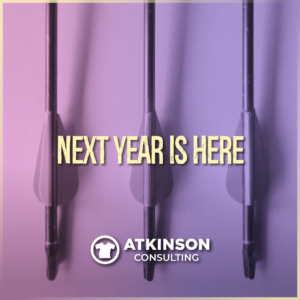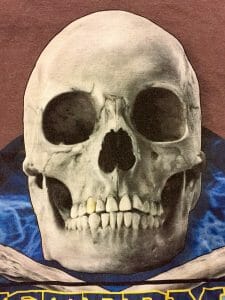The problem with a lot of t-shirt designers is that they get into a rut of churning out the same basic set of designs over, and over and over again. It’s an easy trap to get into, as we often don’t get the luxury of time to come up with an idea that will blow the pants off your client. So besides a bottle of whiskey, where do you look for inspiration? Below are some tips that just might dislodge a creative nugget the next time someone hands you a set of instructions that only read “do something cool”.
- Asymmetrical Balance. Take all your elements and don’t use the align tool. Challenge yourself to make the image balance by the visual mass of the elements instead. Nothing is centered vertically or horizontally – but it all looks correct. It’s harder than it seems – but can lead to some wonderful and playful layouts. One trick to tie everything together could be to use a subtle background texture or shape to tie it all together.
- Restrict Yourself. Just because you can use 12 screens on a press doesn’t mean you have to. Try to design with as few colors as possible for a change. Or, don’t add that extra rule, star or other visual gizmo to the design – delete it! Go minimalistic. Or make the design smaller.
- Think Like Someone Else. Instead of YOU designing the idea – what if you pretended to be someone else. How would they think about it? Be an “Actor” and put yourself into someone else’s shoes. What design choices would they make? Pretend you are a fat plumber, or a ballet dancer, or a lion tamer…anyone but yourself. What personality traits of these people could influence the design?
- Use Textures. Before you start your project, think about how a texture might influence your design. Maybe a rough texture would work – or maybe the opposite and its silky smooth. High tech could mean using a carbon fiber look or a grid. Think about how the texture of the design is going to influence your design choices. Don’t have any textures? Make some! They are simple to construct just using a pic from your camera phone, or scanning in a bag of macaroni or a crumpled up piece of paper. Take a picture of the concrete floor out in your warehouse, or the carpet under your feet. Let the “feel” of the design guide your creative choices.
- Think About Being Absurd. Combine crazy elements together like some weirdo Kafka movie. Have a goldfish riding a bicycle, or a gorilla cooking pancakes. The nuttier the better! If you make yourself laugh while designing, it will be a hit.
- Opposite Direction. Whatever you normally do, do something the polar opposite. For example, let’s say you always use big fat sans serif gothic style type… Try using delicate script or something with an elegant ligature. White becomes black. Hard becomes soft. Peanut butter becomes jelly.
- Start With The Ink. Think about how using a discharge underbase, high density or metallic ink could be used for the project and design around that concept. Use the technical choices of what you need to do to print build your design choices in how the image is conceived.
- Collaborate. Have someone doodle up a design, but you are forced to construct it. This works best with someone that has different design aesthetics than you. (and in fact is how a lot of art directors work – here’s my idea now go build it) The end result has the germ of the original idea, but the design and creativity choices of someone else. Sometimes this produces striking results that are much stronger than if the original person had created it.
- Temperature. When designing think in visual terms of temperature. “Hot” means using warm colors like reds, while “Cold” could mean using cooler blues. Take this another level by using some different thought words to start such as “Steamy” or “Tepid” or “Flash frozen”.
- Juxtapose Elements. Create visual tension by pairing round and pointy, straight and curved, fat and skinny…etc. Pair elements that wouldn’t normally go together or fit. Think about what visual energy is created by balancing a lot of the mass of the design on one small focal point. Use crazy amounts of white space to focus attention on one small, but critical element.
- Bonus. If all else fails, go and have a sandwich or a cup of coffee and quit thinking about it. When you return to your desk the answer will magically appear. Or not.





2 comments
key kumar
Also a small point to add ….when going for discharge prints it is important to see the Colors you choose, as all the colors will not be suitable for discharge. I like the texture point number 4 Where most of the designers fail and it is important during the designing stage instead of doing all the sampling work and finally rejecting after spending lot of money on sampling.
atkinsontshirt
Great points!
I love adding texture to designs, especially verbiage as it adds a lot of “flavor” without much effort. A great trick is to use the shirt color instead of a spot color, which keeps your color count lower.